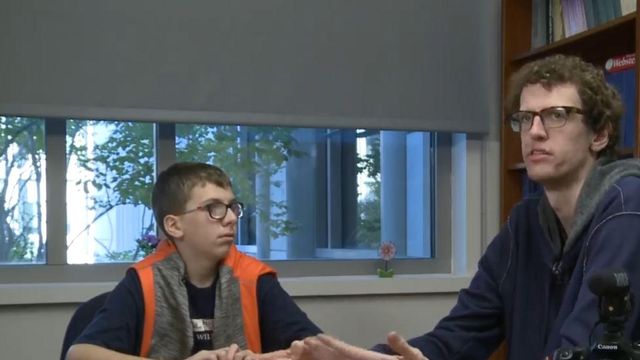Pittsboro teen partners with camp friend to raise understanding of Marfan syndrome
Two teens, including one from Pittsboro, are making a documentary to raise peoples' understanding of Marfan syndrome.
Posted — UpdatedLast April, the two met at a Marfan syndrome family camp. Few kids ever want to be much different than their peers, but a diagnosis of Marfan syndrome can cause children to stand out.
Now, Johnson, 13, of Pittsboro, and Nelson, 17, who live in Georgia, are helping more people understand the potentially life-threatening genetic disorder.
"But like, when I first saw him, like, 'Oh my gosh, he's 7 foot tall,'" Johnson said of meeting Nelson. "Because I had never seen a 7-foot person before."
According to the Marfan Foundation, Marfan syndrome is a genetic disorder that affects the body’s connective tissue. Connective tissue holds all the body’s cells, organs and tissue together. The tissue also serve a vital role in helping the body grow and develop properly.
Unusual height is one possible result of Marfan Syndrome, a progressive degenerative disease of the body's connective tissues.
"This person has more joint issues, another one may have heart issues or cardiac issues, or another may have lenses that move or dislocate early on," said Duke University Opthalmologist Dr. Sharon Freedman.
Freedman helped diagnose Johnson's condition eight years ago. For him, the connective tissues that hold his eye's natural lens in place failed, affecting his vision.
Freedman surgically removed Johnson's lenses and prescribed special glasses.
"So, he can see better than you and I, with his glasses," said Heather Johnson, Ole Johnson's mother. "They're very thick glasses."
The same issue that affected his eyes, though, also requires the attention of a team of specialists, including a cardiologist and orthopedist.
Nelson remembers his own fear-filled array of maladies.
"You know, like, 'Oh, your aorta could dissect at any moment' (or) 'You could have a lung collapse,'" Nelson said. "That kind of sunk me into a little bit of a depression."
What Nelson and Ole Johnson learned, though, is that all the problems are treatable.
As part of a documentary he's producing, Nelson recently went to a Marfan conference.
"I met people who are in all stages of life with Marfan syndrome, people who were in their 70s, who were retired," Nelson said.
Nelson also chose Johnson out of a crowd of kids he met at the Marfan camp to feature in his doc.
"He opened up a little more to us and, kind of, his story reminded me a lot of my own," Nelson said.
Nelson inspired Johnson to look forward to a long, productive life of fun and creativity. Johnson even drew the logo that now appears on Nelson's business card.
Just meeting the 7-foot-tall documentarian changed Johnson's outlook.
"He's really nice," Johnson said of Nelson. "He's like, 'Oh, it's going to be fine.' Stuff like that."
Johnson was part of a study through Duke for four years. He's now on medication to slow down the growth of his aorta near his heart and will one day face surgeries to correct that and other heart issues.
Doctors say Johnson was very fortunate to be diagnosed at a young age so that certain symptoms could be managed and treated before they become more serious.
Nelson wasn't diagnosed until he was 11 years old, and others often aren't diagnosed until even later when life-threatening heart or lung issues appear.
Nelson hopes his documentary will lead to more early diagnosis and better medical management for affected families.
• Credits
Copyright 2024 by Capitol Broadcasting Company. All rights reserved. This material may not be published, broadcast, rewritten or redistributed.





